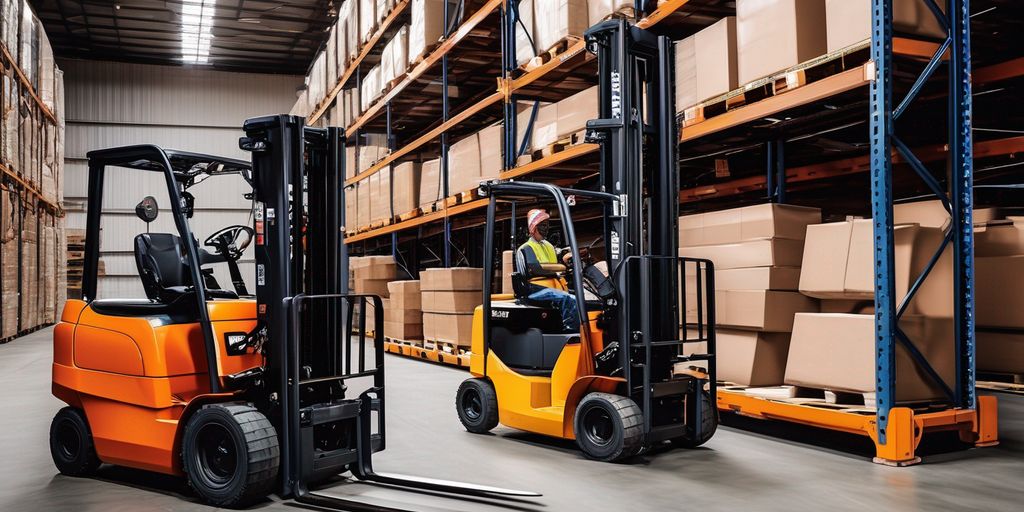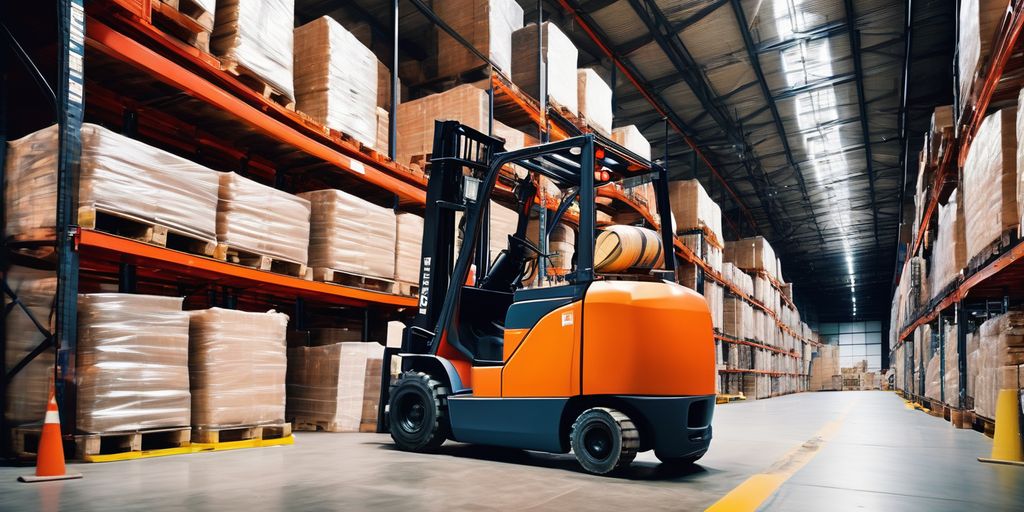Safety First: Best Practices for Operating a Forklift — overview
Operating a forklift safely is crucial in any industrial or construction setting to prevent accidents and ensure the safety of all personnel. This article outlines the best practices for operating a forklift, focusing on understanding its controls, handling loads properly, and maintaining clear visibility, among other important factors.
Key Takeaways
- Familiarize yourself with the forklift's controls and capabilities to ensure safe operation.
- Always handle loads with care and follow proper loading procedures to maintain balance and stability.
- Maintain a clear line of sight at all times to avoid collisions and operate safely.
- Be vigilant about pedestrian traffic and maintain a safe distance to prevent accidents.
- Conduct daily inspections of the forklift to identify and address potential safety hazards.
1. Understand the Controls and Capabilities

Proper forklift operation begins with a thorough understanding of the controls and capabilities of the machine. Operators should be familiar with all operational aspects, including steering, lifting, and maneuvering. Regular practice and adherence to operational guidelines ensure safety and efficiency in the workplace.
It is crucial to know your equipment well. Different models, like a port container truck or a pallet jack, require specific skills due to their unique capabilities and limitations.
Key Points to Remember:
- Know your responsibilities as an operator.
- Conduct proper operator training.
- Regularly inspect the forklift before use.
- Understand the lift’s capabilities in terms of speed, loads, and lift height.
2. Handle Loads Properly

Handling loads properly is crucial for maintaining safety and efficiency in forklift operations. Always ensure loads are properly balanced, secured, and are within the forklift's load capacity before lifting or moving. Here are some steps to ensure safe load handling:
- Assess the load before lifting to ensure it is suitable for the forklift's capacity.
- Ensure the load is evenly distributed on the forks.
- Secure the load to prevent shifting during movement.
- Maintain load stability by placing the load as far back on the forks as possible and keeping the load's center of gravity low.
- Use extra caution when handling off-center loads or those that are unusually shaped.
- Refrain from tilting the forks unless the forklift is stationary and directly above the deposit position.
By adhering to these guidelines, operators can minimize the risk of load-related accidents and enhance operational safety.
3. Keep a Clear Line of Sight

Maintaining a clear line of sight is crucial for safe forklift operation. Operators often face challenges with oversized loads that can obscure their vision. It's essential to ensure maximum visibility at all times to prevent accidents. When visibility is compromised, operators have several strategies to enhance safety:
- If the load obstructs your view, consider traveling backward or enlist the help of a forklift spotter.
- Always keep windows and mirrors clean to maintain visibility.
- Use the horn to alert others when moving around corners or in areas with restricted sight.
- If necessary, stop the forklift and verify that it's safe to proceed before continuing.
Remember, reduced visibility not only endangers the operator but also everyone in the vicinity. Taking proactive steps to maintain clear visibility can significantly reduce the risk of accidents.
4. Look Out for Pedestrians

Forklift operators must prioritize pedestrian safety to prevent accidents and fatalities. In 2017, pedestrian collisions accounted for 13% of forklift-related deaths. Operators should always be vigilant and cautious, especially in areas with high pedestrian traffic such as intersections, corners, and near doors.
Best Practices for Operators:
- Sound the horn at corners or obscured areas to alert pedestrians.
- Always make eye contact and use hand signals to communicate intended movements.
- Grant pedestrians the right-of-way at all times.
- Never approach a pedestrian who is against a fixed object; always allow ample space.
Responsibilities of Pedestrians:
- Walk on the designated side of aisles.
- Maintain a safe distance from operating forklifts.
- Be aware of the forklift's tail swing to avoid accidents.
By adhering to these guidelines, both operators and pedestrians can contribute to a safer working environment.
5. Separate Foot and Forklift Traffic

Ensuring the safety of both pedestrians and forklift operators within a facility is crucial. Implementing strict traffic management policies can significantly reduce the risk of accidents. Here are some effective strategies:
- Use gates, barriers, and markings to clearly delineate areas for foot and forklift traffic.
- Maintain proper aisle widths to ensure safe distances between equipment and pedestrians.
- Designate specific aisles for either pedestrian or forklift use only.
- Install physical barriers and pedestrian safety gates around workstations and walkways to prevent accidental intrusions.
It is essential to limit forklift traffic in areas where pedestrians congregate, such as break rooms and exits, to enhance safety.
By adhering to these guidelines, facilities can create a safer environment for everyone involved, minimizing the likelihood of preventable injuries.
6. Use the Right Equipment to Elevate Workers

When elevating workers, it's crucial to use equipment specifically designed for lifting personnel, such as mobile elevated work platforms (MEWPs) including scissor lifts and boom lifts. Using inappropriate equipment like forklifts for lifting people is extremely dangerous and can lead to severe injuries or fatalities. If a forklift must be used, ensure it is equipped with an approved lifting cage where personnel can secure themselves safely.
Ensure all safety protocols are followed when using lifting cages, including securing all gates and harnesses before elevation.
Here are some key points to consider:
- Always use equipment designed for lifting people.
- Never allow workers to stand directly on the forks of a forklift.
- Ensure the lifting equipment, like MEWPs, is in good working condition.
- Follow all manufacturer guidelines and safety standards.
7. Ascend and Descend Ramps Properly

Navigating ramps is one of the most dangerous activities for forklift operators due to the instability caused by even slight grades. Always drive slowly on ramps to maintain control and prevent accidents. Here are some key guidelines:
- Ascend or descend ramps slowly: Adhering to this rule helps maintain stability and control.
- Load upgrade when traveling on ramps: Whether moving forward or in reverse, keep the load upgrade to prevent it from falling off the forks.
- Avoid turning on ramps: Turning while on a ramp can easily cause the forklift to tip over. If turning is absolutely necessary, it should be done with extreme caution.
- Back down ramps with a loaded forklift: This technique ensures better control and stability of the load.
It's crucial to tilt the load back and raise it only as far as necessary to clear the road surface when navigating grades.
8. Secure Unattended Forklifts

When a forklift is not in use and considered unattended, it is crucial to ensure it is properly secured to prevent accidents or unauthorized use. Always lower the forks to the ground, turn off the power, and set the parking brake. Additionally, removing the key from the forklift is a necessary step to secure the vehicle further and prevent any unauthorized access.
Steps to Secure an Unattended Forklift:
- Lower the forks completely to the ground.
- Turn off the power to ensure the forklift cannot be operated.
- Set the parking brake to keep the forklift from moving.
- Remove the key to prevent unauthorized use.
It's essential to follow these steps every time a forklift is left unattended, even if only for a short period.
By adhering to these simple but effective practices, you can help maintain a safe work environment and ensure that the forklift is always ready for the next shift.
9. Follow Safe Refueling Procedures

Refueling forklifts requires strict adherence to safety protocols to prevent accidents and ensure the safety of the operators. Turn off the forklift before beginning the refueling process to eliminate any risk of ignition. Refuel only at designated locations that are free from open flames and sparks. It's crucial to avoid any sources of ignition, including smoking, during refueling.
Key Steps for Safe Refueling:
- Ensure the forklift is completely turned off.
- Conduct refueling at a designated refueling station.
- Use proper lifting techniques when handling heavy propane tanks.
- Close the service valve on propane tanks after refueling to prevent leaks.
- Clean up any spills immediately to prevent slip hazards and potential fires.
Always follow the manufacturer's guidelines and workplace safety protocols during refueling to maintain a safe working environment.
10. Perform Daily Inspections

Performing daily inspections on forklifts is crucial to ensure the safety and functionality of the equipment. Before each shift, operators should conduct a thorough inspection to identify any potential issues that could lead to accidents or malfunctions. This routine check should include the following key components:
- Brakes
- Steering mechanisms
- Hydraulic systems
- Tires
- Mast chains, hooks, and rollers
- Overhead guard assemblies
- Lights, horns, and mirrors
It is essential to report any problems immediately to the shift supervisor and remove the forklift from service if necessary.
Additionally, maintaining a daily inspection record is not only a regulatory requirement but also a best practice to ensure continuous safety compliance and operational readiness.
Conclusion
In conclusion, adhering to best practices for operating a forklift is crucial for ensuring safety in the workplace. From understanding the fundamentals of forklift operation to implementing rigorous safety protocols and staying updated with the latest safety standards, every step is vital. It is the responsibility of both employers and employees to foster a safety-first culture. Regular training, proper maintenance, and a thorough understanding of the operating environment will significantly reduce the risk of accidents and enhance overall efficiency.
Frequently Asked Questions
What are the fundamental controls I should understand before operating a forklift?
Understanding the steering, lifting, and maneuvering controls is crucial. Familiarize yourself with all operational aspects through regular practice and adherence to guidelines.
How should loads be handled safely?
Always ensure loads are stable and secure. Use appropriate lifting techniques and do not exceed the forklift's rated capacity.
What should I do to maintain a clear line of sight while operating a forklift?
Keep the load at a safe height and ensure your view is unobstructed. Regularly check the operating environment for obstacles or changes.
How can I ensure the safety of pedestrians while operating a forklift?
Always be vigilant, use appropriate warning signals, and maintain a safe speed. Ensure pedestrians are aware of the forklift's presence.
What procedures should be followed to secure an unattended forklift?
Lower the forks to the ground, set the parking brake, remove the key, and close the service valve on propane tanks.
What are the best practices for refueling a forklift safely?
Follow manufacturer guidelines, ensure the area is well-ventilated, and avoid any sources of ignition. Always wear protective equipment during refueling.




Leave a comment
This site is protected by hCaptcha and the hCaptcha Privacy Policy and Terms of Service apply.